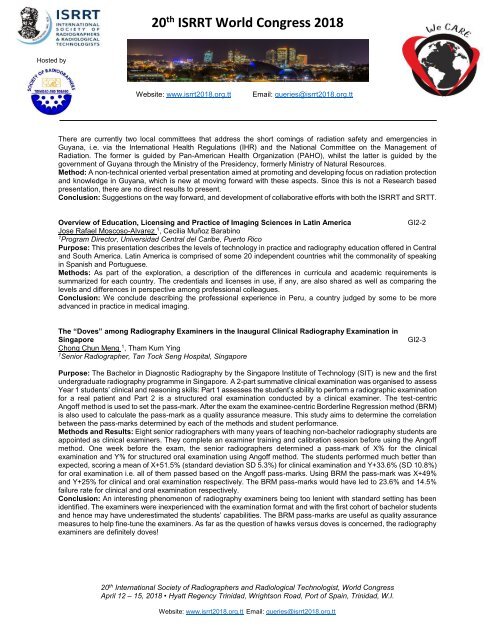Trinidad-and-Tabago-Congerss-Abstract-Book
Create successful ePaper yourself
Turn your PDF publications into a flip-book with our unique Google optimized e-Paper software.
20 th ISRRT World Congress 2018<br />
Hosted by<br />
Website: www.isrrt2018.org.tt<br />
Email: queries@isrrt2018.org.tt<br />
There are currently two local committees that address the short comings of radiation safety <strong>and</strong> emergencies in<br />
Guyana, i.e. via the International Health Regulations (IHR) <strong>and</strong> the National Committee on the Management of<br />
Radiation. The former is guided by Pan-American Health Organization (PAHO), whilst the latter is guided by the<br />
government of Guyana through the Ministry of the Presidency, formerly Ministry of Natural Resources.<br />
Method: A non-technical oriented verbal presentation aimed at promoting <strong>and</strong> developing focus on radiation protection<br />
<strong>and</strong> knowledge in Guyana, which is new at moving forward with these aspects. Since this is not a Research based<br />
presentation, there are no direct results to present.<br />
Conclusion: Suggestions on the way forward, <strong>and</strong> development of collaborative efforts with both the ISRRT <strong>and</strong> SRTT.<br />
Overview of Education, Licensing <strong>and</strong> Practice of Imaging Sciences in Latin America<br />
GI2-2<br />
Jose Rafael Moscoso-Alvarez 1 , Cecilia Muñoz Barabino<br />
1 Program Director, Universidad Central del Caribe, Puerto Rico<br />
Purpose: This presentation describes the levels of technology in practice <strong>and</strong> radiography education offered in Central<br />
<strong>and</strong> South America. Latin America is comprised of some 20 independent countries whit the commonality of speaking<br />
in Spanish <strong>and</strong> Portuguese.<br />
Methods: As part of the exploration, a description of the differences in curricula <strong>and</strong> academic requirements is<br />
summarized for each country. The credentials <strong>and</strong> licenses in use, if any, are also shared as well as comparing the<br />
levels <strong>and</strong> differences in perspective among professional colleagues.<br />
Conclusion: We conclude describing the professional experience in Peru, a country judged by some to be more<br />
advanced in practice in medical imaging.<br />
The “Doves” among Radiography Examiners in the Inaugural Clinical Radiography Examination in<br />
Singapore<br />
Chong Chun Meng 1 , Tham Kum Ying<br />
1 Senior Radiographer, Tan Tock Seng Hospital, Singapore<br />
GI2-3<br />
Purpose: The Bachelor in Diagnostic Radiography by the Singapore Institute of Technology (SIT) is new <strong>and</strong> the first<br />
undergraduate radiography programme in Singapore. A 2-part summative clinical examination was organised to assess<br />
Year 1 students’ clinical <strong>and</strong> reasoning skills: Part 1 assesses the student’s ability to perform a radiographic examination<br />
for a real patient <strong>and</strong> Part 2 is a structured oral examination conducted by a clinical examiner. The test-centric<br />
Angoff method is used to set the pass-mark. After the exam the examinee-centric Borderline Regression method (BRM)<br />
is also used to calculate the pass-mark as a quality assurance measure. This study aims to determine the correlation<br />
between the pass-marks determined by each of the methods <strong>and</strong> student performance.<br />
Methods <strong>and</strong> Results: Eight senior radiographers with many years of teaching non-bachelor radiography students are<br />
appointed as clinical examiners. They complete an examiner training <strong>and</strong> calibration session before using the Angoff<br />
method. One week before the exam, the senior radiographers determined a pass-mark of X% for the clinical<br />
examination <strong>and</strong> Y% for structured oral examination using Angoff method. The students performed much better than<br />
expected, scoring a mean of X+51.5% (st<strong>and</strong>ard deviation SD 5.3%) for clinical examination <strong>and</strong> Y+33.6% (SD 10.8%)<br />
for oral examination i.e. all of them passed based on the Angoff pass-marks. Using BRM the pass-mark was X+49%<br />
<strong>and</strong> Y+25% for clinical <strong>and</strong> oral examination respectively. The BRM pass-marks would have led to 23.6% <strong>and</strong> 14.5%<br />
failure rate for clinical <strong>and</strong> oral examination respectively.<br />
Conclusion: An interesting phenomenon of radiography examiners being too lenient with st<strong>and</strong>ard setting has been<br />
identified. The examiners were inexperienced with the examination format <strong>and</strong> with the first cohort of bachelor students<br />
<strong>and</strong> hence may have underestimated the students’ capabilities. The BRM pass-marks are useful as quality assurance<br />
measures to help fine-tune the examiners. As far as the question of hawks versus doves is concerned, the radiography<br />
examiners are definitely doves!<br />
20 th International Society of Radiographers <strong>and</strong> Radiological Technologist, World Congress<br />
April 12 – 15, 2018 • Hyatt Regency <strong>Trinidad</strong>, Wrightson Road, Port of Spain, <strong>Trinidad</strong>, W.I.<br />
Website: www.isrrt2018.org.tt Email: queries@isrrt2018.org.tt


















